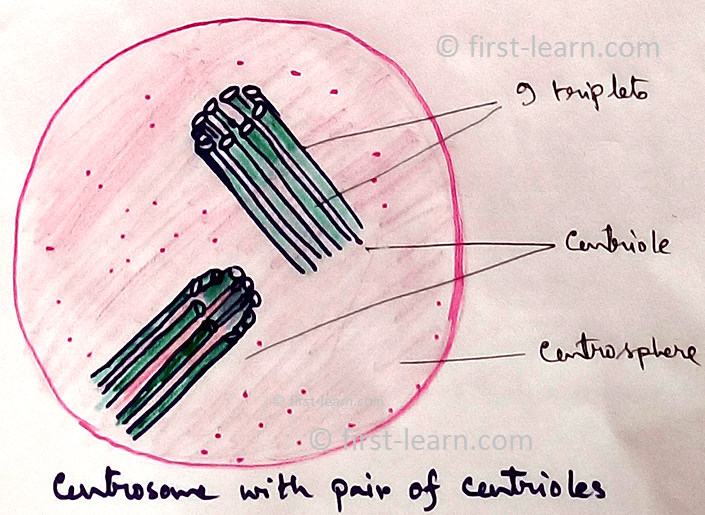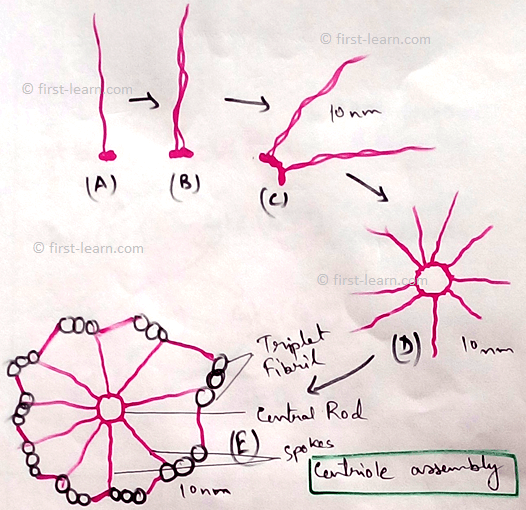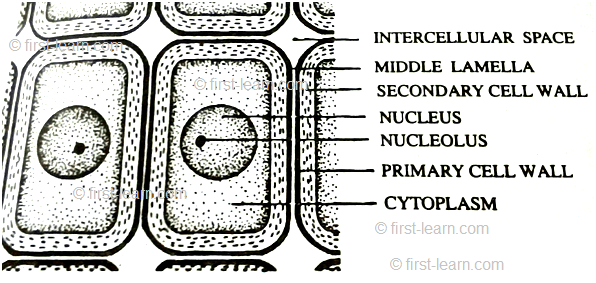Centrosome and Centrioles
Definition of Centrosome - Centrosomeis a more or less spherical mass of dense cytoplasm situated close to the nucleus and contains a pair of cylindrical bodies which are concerned with spindle formation during cell division. In 1888 Boveri first discovered these organelles and gave its name.
Distribution of the Centrosome – Centrosome is observed in almost all the animal cells, as it is associated with the spindle formation of the cell during cell division. But in plant cells centrosome is totally absent except some lower plants like algae. Thus during cell division spindle is not formed during cell division of plant cell.
Chemical Composition of Centrosome - Chemically these are made up of protein, carbohydrate, lipid, nucleic acid (RNA and probably DNA).
Structure of Centrosome - Kinoplasm is the organising material of centrosome. It can be divided into two part. These are – Centrioles and centrosphere. At the middle portion of the centrosome contains two hollow cylindrical structure called Centrioles which lying their long axis . These two Centrioles of the centrosome are called diplosome.
The wall of Centrioles are made of 9 longitudinally arranged bundles of microtubules. Each of them is connected to the adjacent one by a central rod by means of protein fibres.It seems like a cart wheel. Microtubules bundles are radially equidistant from the adjacent ones . Each single bundle is composed of set of three microtubules called triplet microtubules. They are parallel to each other and are arranged tangentially to the circumference of the centrioles. Each of them has a diameter of 250 angstroms and wall is made up of 13 fillaments of globular proteins with a diameter of 45 angstroms. Some of the spheroidal bodies known as centriolar satellites encircle the whole centrioles in two circumferential rows.
Definition of Centrioles - Centrioles are pair of cylindrical shape hollow organelles which is associated with spindle formation during cell division and is a part of centrosome.
Origins of Centrioles - The process of formation of Centrioles are still unknown centrioless are originated from the pre existing one by the process called replication.It is observed that, during the this, a procentriole is formed behind the mother Centrioles and each of them remain at right angle to its respective mother Centrioles. Procentrioles are look like mother Centrioles but are shorter in length. Then the microtubules increase in length and converted to mature Centrioles.Procentrioles are lied very close to the mother Centrioles but in a definite arrangement. Though they don’t have any connections between them and it seems clear that unequivocally a new Centrioles originates by the division of a pre existing Centrioles.
Functions of the Centrosome:
Functions of Centrosome are –
1. Formation of Centrioles - Centrioles are formed from the Centrosome during cell division.
2. Plays role in cell Division - At the time of cell division ,the centrioles form spindle fibres that help in migration of daughter chromosome towards the pole.
3. Movement of Locomotion - Centrioles help in the formation of cilia,flagella,tail of sperms. These are made up of microtubules and function as organs of movement and locomotion of certain cells.
From Centrosome and Centrioles to HOME PAGE
Recent Articles
-
What Is Plasma? | Blood Plasma | Proteins | Nutrients | Cholesterol
Nov 07, 25 10:29 AM
Blood is a mobile fluid which is a connective tissue and is derived from the mesoderm like cell any other connective tissue. Colour of blood is reddish and that flows inside the blood vessels by means… -
Disorders of Respiratory System | Tuberculosis | Pleurisy | Emphysema
Oct 28, 25 11:39 PM
Tuberculosis is very common disease and is caused by a type of bacteria called Mycobacterium tuberculosis. This disease causes different trouble in the respiration and infection of several parts of th… -
Regulation of Respiration | Respiratory Centres | Inspiratory Area |
Oct 14, 25 12:13 AM
Respiratory Centre is the area that controls the rate of respiration and it is observed to be located in medulla oblongata and pons. Respiratory Centre has the following will dispersed components like… -
Explain Transport of Gases | External Respiration | Tissue Respiration
Oct 09, 25 11:35 PM
In humans gaseous exchange is completed in the following ways the steps are - External Respiration or Breathing - Breathing in false taking in of Oxygen and giving out of carbon dioxide in the body. M… -
Kind and Number of Teeth | Location of Teeth in Mouth | Care of Teeth
Sep 11, 25 12:52 AM
Kind and Number of Teeth
















New! Comments
Have your say about what you just read! Leave me a comment in the box below.